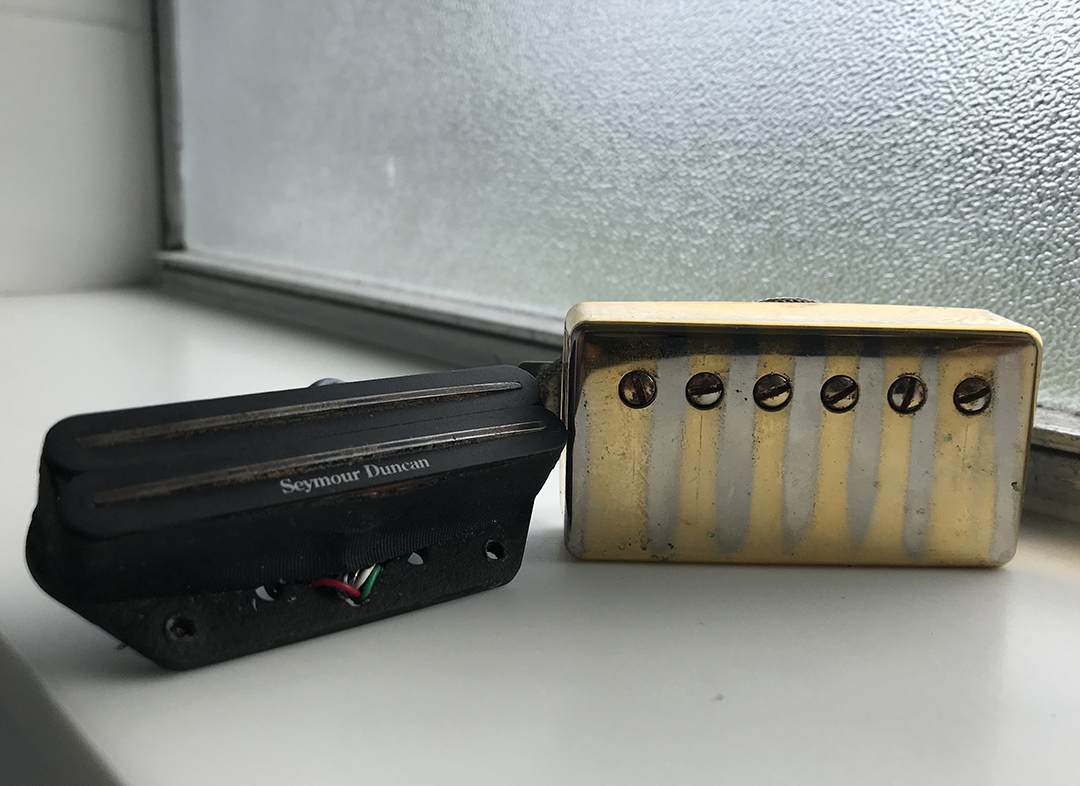
By Ed Malaker
Posted 12/04/2019
When choosing a new pickup for your guitar, the magnet is one of the most essential yet complicating elements involved in the sound creation process. We’ll try to demystify the process by looking at the issue of alnico vs ceramic magnets and how they affect your guitar’s tone. You’ll see in this discussion that these types of magnets produce different kinds of sounds – so many that your decision-making may prove challenging.
The type of magnet that a pickup uses is one of the things that they like to hype-up in advertisements. This magnet sounds bright, and that magnet sounds warm, but is there any validity to what they are saying? Do the different types of magnets make any difference at all?
We’re going to take a look at several different types of magnets in detail to see exactly who wins in an alnico vs ceramic magnets shootout. So keep reading while we look at composition, strength, polarity, and more, to help unlock the mystery surrounding pickup magnets.
Magnet Composition
A great place to start our alnico/ceramic magnets discussion is with the composition of each type of magnet.
Ceramic Magnets
Ceramic magnets came out in the 1960s and became popular because of the high cost of metal magnets. They’re also known as ferrite magnets, and three out of four magnets you encounter in your life are ceramic. Iron oxide and strontium carbonate are mixed and heated to very high temperatures to create the magnet, which is how they get their ceramic name. The magnets are then allowed to cool in a magnetic field to pick up their magnetic charge.
Ceramic magnets are typically stronger than Alnico magnets, so they produce more output. The stronger magnetic field is also said to put out more high-end frequencies, potentially leading to a harsh and brittle tone.
Alnico Magnets
An alnico magnet gets its name from the aluminum, nickel, and cobalt that it contains, but alnico also contains many other elements and is mostly iron. The actual composition of alnico can vary quite a bit. These magnets are softer than ceramic magnets and provide a weaker magnetic field. The weaker magnetic field created by alnico magnets is said to give them a warmer, smoother quality than a ceramic magnet, but at the cost of reduced gain.
Alnico Magnet Numbers
There are different numbers associated with alnico magnets, such as alnico 2, or alnico 5. These numbers are usually written as Roman numerals, like Alnico II, or Alnico V. These numbers refer to the ratio of aluminum to nickel to cobalt. Different ratios yield magnets of varying strength. Alnico II is the weakest and favored by many jazz players. Alnico II magnets are said to have a soft and articulate sound with smooth highs.
As you move through the numbers toward Alnico V, the magnets become progressively stronger, producing more gain and adding more midrange “bite” to the tone of the guitar. Many metal guitarists favor Alnico V magnets for their high output and aggressive tones.
Our research indicates that alnico numbers progress to as high as 12. Alnico VII is in some pickups, but this is rare.
Alnico vs Ceramic Magnets
To crown a winner in our Alnico vs Ceramic Magnets shootout, we would need a way to accurately compare the two, which is not an easy task. Alnico seems to be the popular favorite, but, on the other hand, there is no shortage of popular recordings that feature ceramic pickups.
The best thing to do is to use your ears to decide for yourself.
Examples of ceramic pickups
- Dimarzio Crunchlab
- Dimarzio Super Distortion
- Seymour Duncan Hot Rails
- Seymour Duncan Little ’59
- Fralin Split Blade
Examples of alnico pickups
- Dimarzio Red Velvet
- Dimarzio Twang King
- Seymour Duncan Live Wire 2
- Seymour Duncan Red Devil
- Fralin Blues Special
- Fralin Jazzmaster
Conclusion
Unfortunately, there is no clear winner in our alnico vs ceramic magnets debate. There are just too many completely subjective variables to make a definitive decision. If forced into it, we might recommend alnico, only because ceramic is the magnet of choice in cheap pickups that often sound bad. Since alnico is more expensive, it is usually used to create better quality products.
We recommend that you try out as many different pickups as you can. Take notice, but don’t pay too much attention to the magnet. Listen to the sound.
We hope that we have helped you learn a little bit more about the difference between ceramic and alnico magnets. If you enjoyed reading and have an opinion about who wins the alnico vs ceramic magnets showdown, we’d love to hear it. If you’ve found this article helpful, please feel free to share it with your friends on Facebook and Twitter. For more articles on guitar electronics, visit humbuckersoup.com.
